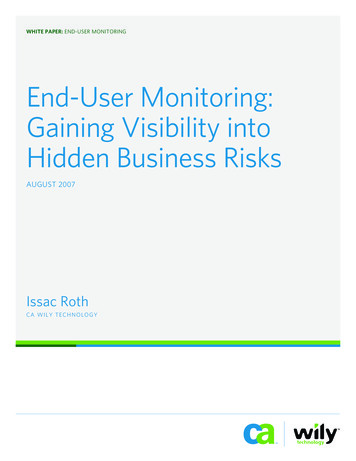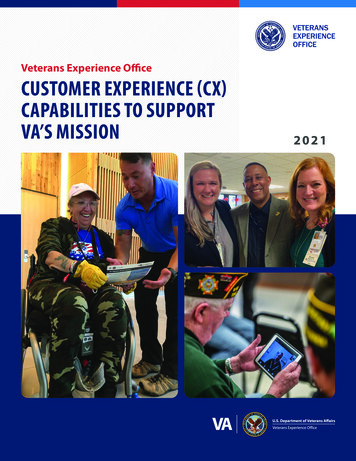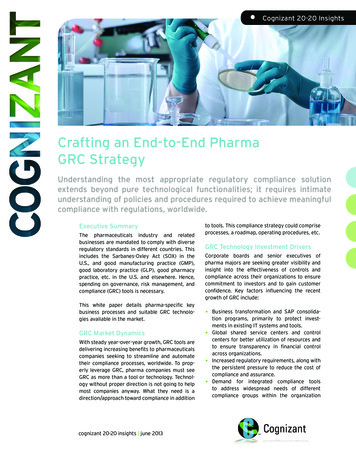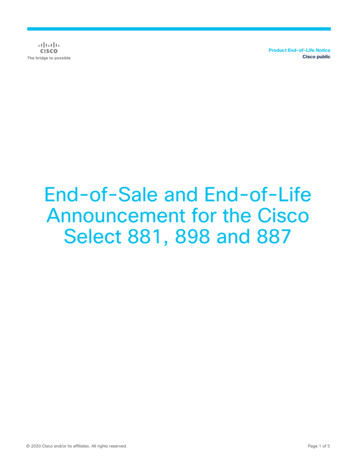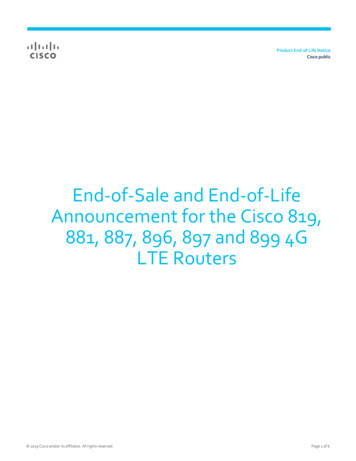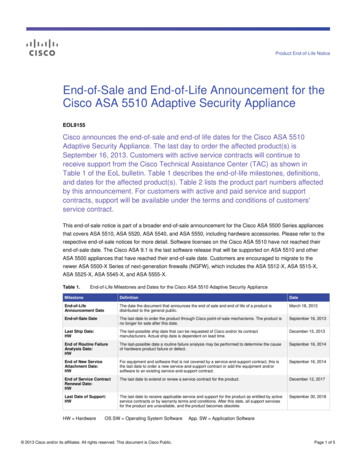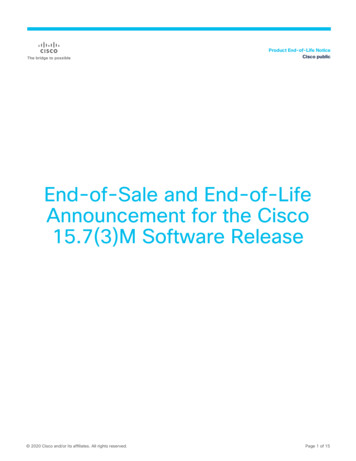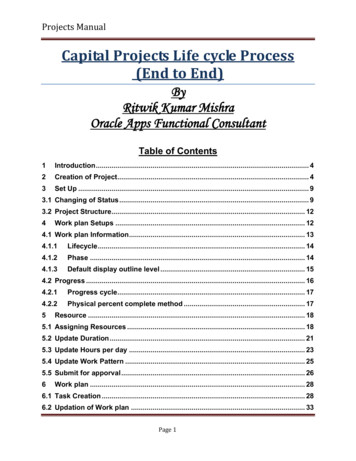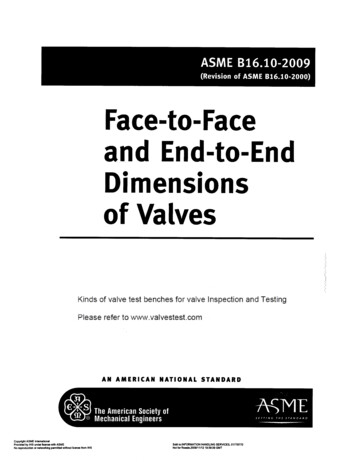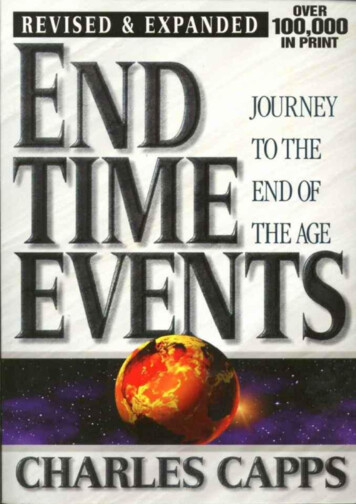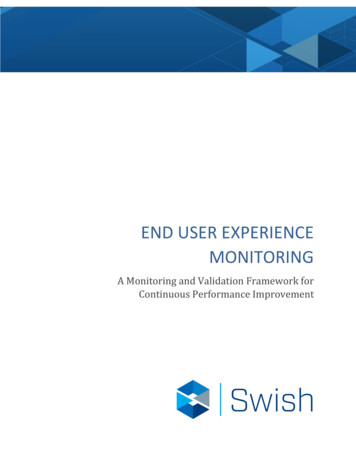
Transcription
END USER EXPERIENCEMONITORINGA Monitoring and Validation Framework forContinuous Performance Improvement
THE CHALLENGEThe inability to see what users are experiencing as they interact with applications negativelyimpacts mission attainment for many government agencies. In trying to solve the lack ofvisibility problem, many agencies find themselves with too many tools and too few solutions.While Network Performance Monitoring (NPM) and Application Performance Monitoring (APM)are mainstays, both approaches leave a visibility gap. Neither address what the end user is trulyexperiencing. They attempt to address end user monitoring through elimination tactics andthird person perspectives but neither provides a first-person view, which is what you get with atrue End User Experience Monitoring (EUEM) solution. Using a EUEM solution gives an agencyreal-time, accurate awareness of performance issues and where they occur. This unlocksadditional value in existing NPM and APM solutions. When the time required to identify aproblem is reduced effectively to zero, the next evolution in observability and troubleshootingbegins.WHAT EUEM BRINGSThe Tech Services Industry Association (TSIA) states that when it comes to support metrics,there are 4 categories that matter: Volume StaffingEmployee ProductivityCustomer ExperienceFinancialA properly instrumented EUEM solution addresses all 4 of these categories. Knowing the volumeof software and application usage provides valuable information for both staffing and softwarelicense counts. Knowing how applications are performing impacts both employee productivityand the customer experience. These metrics help to evaluate the ability of an agency toefficiently delivery on mission attainment, with the resources on hand. End User ExperienceMonitoring provides actionable insights into the experience of the personnel driving the agency’smission, allowing for instant quantification of problems, which leads to immediate response toperformance impeding events. And, EUEM delivers substantial ROI savings.AGENCY GOALSUsing Aternity, Swish provides a fully functioning End User Experience Management solution toDHS which enabled immediate validation and insights into what the agency is truly providing toall end users. With each member of the Swish team having more than 15 years of experience inperformance engineering, they worked loosely with DHS to install, train, and fully integrate theAternity EUEM solution, empowering agency personnel to efficiently address all aspects ofenterprise end user experience.1
The Swish team’s specialized engineers engage agency staff and resources in identifying potentialvisibility gaps and mission critical targets, personnel and applications. Upon identification theycollaborated with DHS personnel to devise a plan of action with the following objectives: Instrument target applications with Aternity EUEM agents.Create custom monitoring for transactional insights into target applications.Create dashboards and reports to monitor, analyze, validate and troubleshoot end users,applications and endpoint performance.Provide role-based adoption training to maximize the value of the Aternity EUEM olution.Devise a plan of action surrounding the long-term integration of Aternity with existingDHS solutions, such as Splunk, ScienceLogic, and ServiceNow.This engagement resulted in expedited ROI for existing investments, increased staff efficiencies,greater performance transparency, and improved decision-making.AGENCY BENEFITSSwish’s implementation of Aternity EUEM provided the following benefits to DHS: Reduced Mean Time to Response (MTTR)Reduced Mean Time to Identify (MTTI)Accurate inventorying of agency-wide software; combatting “shadow IT”Validation of SaaS, security, VDI, and other infrastructure changesQuantification of cloud and SaaS SLAs; holding vendors accountable for service deliveryValidation of other tools and software solutions. Aternity is a great tool for use in Proof ofConcept evaluations.Because Aternity accounts for time spent in every application used across the agency, it can beinstrumental in determining software usage; potentially reducing investments in software “Thatare” under-utilized. Using Aternity, many agencies also find that previous estimates on softwarerequirements were high. Lastly Aternity has the added benefit of enhancing the value and ROI of“existing monitoring and troubleshooting solutions.2
SWISH ADDED VALUEIn addition to the above-mentioned benefits, the Swish Center of Excellence (CoE) team providesa direct lifeline to critical support. This team provides architect-level engineering expertisewhich serves as a guide through the complex challenges in today’s technological landscape. Thisteam includes several former Riverbed employees, including Sean Applegate, Riverbed PublicSector CTO, who serves today as Swish’s CTO. Sean worked at Riverbed for over nine years,supporting many of the largest deployments in the world. He directly brings extensive real-worldexperience to insure customers’ EUEM success.RETURN ON INVESTMENTMajor business analysts unanimously agree that end-to-end observability with proactive problemidentification - backed by detailed monitoring, analysis, troubleshooting and validationcapabilities - delivers tremendous ROI benefits. A breakout of the formulas and data sources usedto determine approximate ROI’s are included in the following sections.Helpdesk Trouble TicketsEUEM dramatically reduces MTTR and outages by providing insights into mission criticalapplication performance. EUEM also quantifies and verifies performance after software updates,patches, cloud migration, and other configuration changes. The cascading benefits result inhigher productivity from IT and support staff, as well as increased productivity due to theavailability and speed at which end users can access mission critical applications. This forcemultiplier effect results in more productive use of IT staff resources, which in turn enables acombined reduction in service tickets and manpower. The following formulas are used forapproximating the ROI for an organization consisting of 15,000 users which is the approximatenumber of users within DHS.Tickets/MonthAverage Helpdesk CostsCost/TicketTotal17,10015.56 266,076Figure 1 – Average service desk cost per ticket.13
This brings the total annual cost of the organization’s help desk to 3,192,912. With Aternityreducing ticket volume by 15%2 a savings of 478,936 per year can occur. Over 5 years, thisaccounts for 2,394,684 in savings for help desk tickets alone.Software License ConsolidationAnother way Aternity can assist in savings is through software license consolidation andvalidations. Unused software not only causes a larger attack surface for security intrusions, it isalso financially inefficient. Figure 2 illustrates that the average waste per user on softwarelicensing in the US and the UK is 247/user.Figure 2 - Software waste is defined as any piece of software that has been deployed to a desktop, but is not being run bythe user. An application is determined to be “unused” if it has not been run within the last 90 days, and “rarely used” if ithas not been run within the past 30 days. “Total Waste” is the combined sum of both.3Software License CostsCost/userUsersTotal 24715,000 3,705,000Figure 3 – Using 15,000 DHS users; software license costs total almost 4M.Aternity provides detailed reports of software usage per user. If inventorying does not exist toaddress software usage, there is potentially up to 4 million in savings that an organization ofthis size might recognize. If you assume that DHS operations has addressed software waste, thepotential savings drops to 5% which is 185,250/year.4
Figure 4 shows the composition of a service desk ticket:Figure 4 – Service desk ticket composition4Figure 5 shows the potential savings as it pertains to EUEM:Service Desk Cost MetricsCost Per TicketCost Per Minute to Handle TimeNorth American StatisticsAverageMinMax 15.56 2.93 49.69 1.60 0.76 2.50Figure 5 – Service desk average cost per ticket5Incidents per seatper monthService requests perseat per monthTotal tickets perseat per monthFinancial HighStatistic Services Tech Equip Mfg TelecomAvg0.67 0.560.390.43Min0.19 0.140.110.12Max1.95 1.821.241.56Avg0.32 0.420.220.31Min0.1 0.290.140.13Max1.2 1.410.620.94Avg0.99 0.980.610.74Min0.29 0.430.250.25Max3.15 3.231.862.5BusinessEnergyServices Healthcare 173.511.011.6Figure 6 – Average help desk tickets and incidents per month, per industry65
Figure 7 –ROI impact on trouble tickets with AternitySoftware License SavingsKnowing specifically which users are using what software and how often, results in significantsavings on hardware and software. While these savings are generally recognized in the first year,additional ongoing savings occur when using Aternity. The market research referenced in Figure8 provides validation of this savings:25-50% ment-calculator30% nagement-Savings25-75% t-s-biggest-money-wasters.htmlFigure 8 – Market research on hardware and software savings6
Figure 9 – Unused software by industry.7Figure 10 –ROI impact on software licensing cost per year7
ROI SUMMARYThe most striking metric regarding Aternity’s ROI is perhaps the following:Figure 11 – Aternity payback period8Figure 12 below takes into account industry metrics on help desk costs, software costs, MTTRand Aternity’s proven impact on the typical deployment. These numbers are generallyconservative, considering Swish ensures successful adoption, integration, and training for thesolution.ROI Breakdown (5 yr)Help deskSoftwareMTTR/OperationalEfficiencyTOTAL 2,394,680 926,250 276,412 3,597,342Figure 12 – ROI breakdown over a five-year periodCONCLUSIONIn today’s complex IT environments, like that of DHS, it is imperative to have insights andquantifiable and actionable intelligence into the organizational infrastructure at every level.Network Performance Management and Application Performance Management tools arenecessary but leave a blind spot. They don’t provide insight into what end-users areexperiencing. Adding Aternity to an agency’s portfolio of monitoring tools greatly enhances theorganization’s monitoring and validation framework which becomes the foundation forcontinuous performance improvement.8
Adding the investment in Swish’s performance engineering expertise helps agency’s recognize 10to 15 times return on investment. Furthermore, this expertise results in enhanced end-to-endperformance capabilities, broader workforce enablement, and optimized performance processes.9
tor/euem/aternity.html?utm source blog&utm medium lection aternity-techfacts1 BMCBlog: Service Management – Cost per Ticket; the Ultimate Service Desk chValidate Digital Experience Management Survey talexperience-management231EReport: Software Waste Benchmark Findings -waste-28billion/MetricNet – Metric of the Month: Tickets per User per monthhttps://www.thinkhdi.com/ icles/cost-per-ticket-peruser.pdf45 BMCBlog: Service Management – Cost per Ticket; the Ultimate Service Desk tricNet – Metric of the Month: Tickets per User per monthhttps://www.thinkhdi.com/ icles/cost-per-ticket-peruser.pdf67A1E Report: The Real Cost of Unused Software l Experience Management Survey talexperience-management?collection aternity-techfactsAbout SwishSwish is a customer-centric, specialized integrator with an engineering first culture. Swish focuses on ITModernization, Performance and Cybersecurity solutions. Swish strives to bring value to clients throughcontinuous improvement expertise; robust services, superior engineering and creative solutioning.To Learn more, please visit: www.swishdata.com1420 Spring Hill Road Suite 600 Mclean, VA 22102P 703.635.3324 / F 703.852.7904 / E info@swishdata.com 2020 Swish, Inc. All rights reserved. CS-NA-HCI-0120WP-RB-Atternity-0604-042010
Create dashboards and reports to monitor, analyze, validate and troubleshoot end users, applications and endpoint performance. Provide role-based adoption training to maximize the value of the Aternity EUEM olution. Devise a plan of action surrou
